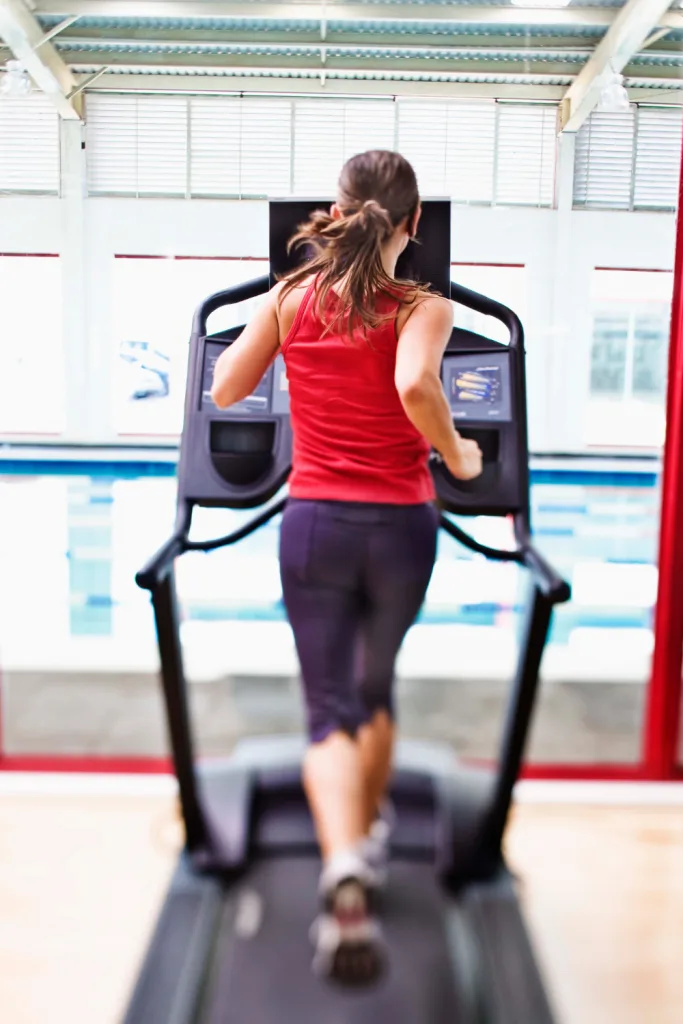Controversial as it may sound – runners don’t lack mileage, they lack strength!
Cross training for runners is often neglected and overlooked by runners who are looking to achieve their goals by simply running.
Whilst this is fine to begin with, it’s important to push your body in different ways and include other types of activities in your routine to continue to build your muscular strength, stamina and endurance.
By including cross training activities in your training routine, you will become a stronger and faster runner in the long term.
In this guide we’ll explore:
- What is cross training for runners?
- What is cross training important for runners?
- What are the benefits of cross training for runners?
- Is cross training good for runners?
- What is the best cross training for runners?
- Is strength training a form of cross training?
- How often should runners cross train?
- 9 reasons to do cross training
Ready?
Let’s get going!

What is cross training for runners?
Cross training is all about including a range of exercises and activities in your training plan in order to push your body and muscles in different ways and improve overall athletic performance.
It focuses not only on your aerobic fitness, but looks to improve your flexibility, balance, coordination, core strength and endurance.
Your body is a good at adapting to different types of movement and it likes to be tested in different ways.
Cross training is proven to strengthen your muscles and help speed your recovery.
Related: 30 day strength training plan for runners
Why is cross training important for runners?
Running is great for your cardiovascular fitness, but over time it can start to negatively impact your muscular strength and endurance.
That’s because running focuses mainly on your aerobic energy systems and targets the muscles in your lower body – think your glutes, quads, hamstrings and hip flexors.
Over time this creates an imbalance.
By including cross training activities in your routine, you even out this imbalance and strengthen weaker or underused muscles, therefore making you less susceptible to injury.
According to a 1995 study, cross training was found to improve the performance of well-trained athletes.
If you’re someone that likes a bit of variety in your training plan, then cross training is a good thing for you to practice regularly.
It can be beneficial for runners who are returning to running following an injury, or those runners that run frequently each week.
Related: 11 symptoms of overtraining: How to overcome running fatigue

What are the benefits of cross training for runners?
When performed regularly as part of a well-rounded training plan, cross training has the following benefits for runners:
- Reduces the risk of common running injuries
- Strengthens your muscles, joints and connective tissues
- Improves your cardiovascular endurance
- Improves running performance and economy
- Adds variety into a training plan
- Improves running motivation
- Provides a physical and mental break from running
Related: Strength training for runners: A complete guide
Is cross training good for runners?
Yes! Cross training is good for runners looking to improve their athletic performance.
As we saw above, cross training has a whole host of benefits for runners looking to improve their performance and running form and it adds variety into a training plan.

What is the best cross training for runners?
There are so many cross training exercises and workouts out there to choose from. The key is to choose the right ones based on your fitness levels, running goals and personal preferences.
Here are some popular cross training exercises for runners:
- Swimming
- Cycling
- Walking
- Stand up paddle boarding (SUP)
- Rowing
- Yoga
- Pilates
- Barre
- Weightlifting and/or weight training
Swimming
Swimming is good for runners because it allows your body to recover after miles and miles of pounding the pavement.
It’s another form of cardiovascular exercise but doesn’t impact your joints as much.
A lot of runners swim when they’re injured to aid recovery as it is low impact.
Cycling
Cycling is a good substitute to running as it works a lot of the same leg muscles, but without the high impact on your joints.
The downside of cycling is that you need quite a lot of equipment to get started – a good bike, a helmet and other bits of gear and safety equipment depending on how fast and far you want to go.
Walking
It’s surprising how much energy you can burn whilst out on a brisk walk.
It’s a great way to whip up a sweat without raising your heart rate too much like you would do in running.
Many beginner running programmes like Couch to 5k incorporate walking intervals as it’s a form of active recovery.
Walking is a great way to recover after a long run, but it’s not advisable to substitute things like tempo running or interval running for walking.
Stand up paddle boarding (SUP)
Stand up paddle boarding (also known as SUP) is all about core strength and stability which can go a long way to improve your overall performance as a runner.
You use your upper and lower body strength to do basic movements on the water.
It’s also a crazy amount of fun on the water!
Rowing
Going all out on a rowing machine for two or three minutes is a killer!
Using a rowing machine in the gym after a strength training session really raises your heart rate and gets your body used to using different energy systems.
When you run, you use mainly the aerobic and lactate energy systems.
Rowing pushes you to use your creatine phosphate (CP) energy system towards the end of your workout to power you through it – think explosive power that lasts for around 2 to 10 seconds.
Yoga
It’s good to get into a habit of stretching every day as a runner, preferably in the morning when you wake up.
Yoga is a great way to improve your flexibility, balance and core strength.
It strengthens the key supporting muscles used in running such as quadriceps, hamstrings and hip flexors.
The movements used in yoga really allow you to focus on your core strength which will help you stay injury free.
Yoga is also a great way to practice your breathing as it gets you into the habit of conscious breathing where you become more aware of sensations in the body.
Pilates
Similar to yoga, Pilates allows you to improve your flexibility and strength.
When you run regularly, you repeatedly use some muscles and underuse others.
Pilates allows you to activate and strengthen any underused or weak areas and create more balance in your body.
It’s also a great tool for tuning up your body for running as it improves your core strength, balance, coordination and posture.
Barre
Barre is great for runners as it helps to improve your flexibility and strength. You can also do a barre workout from the comfort of your own home.
If you’re not familiar with barre, it’s a workout technique inspired by elements of ballet, yoga and Pilates.
It focuses on low impact and high intensity movements designed to strengthen your body in ways that few other workouts can.
Weightlifting and/or weight training
Weightlifting and weight training have many benefits for runners looking to become stronger and faster.
Weight training helps to improve running form and posture as well as running performance when performed regularly as part of a well-rounded training plan.

Is strength training a form of cross training?
Strength training is arguably one of the best cross training activities for runners because it helps to target imbalances and deficiencies as a result of running.
There are many forms of strength training but weight training in particular has been shown to improve running form and performance.
To reap the benefits, focus on weight exercises that target your legs and core.
Check out my guide on strength training for runners for more tips and advice.
How often should runners cross train?
Cross training should supplement your running, not replace it completely.
The amount of cross training you do will depend on how you’re feeling – both mentally and physically. Don’t push yourself too hard.
Try to include at least 1-2 days of cross training in your training plan.
If you’re recovering from an injury, you may need to include more cross training days each week.

9 reasons to do cross training
Here are some 9 reasons why you should be including cross training in your training routine.
#1 Improves your running performance
Cross training has been shown to improve the performance of athletes when performed regularly as part of a well-rounded training plan.
According to a 1995 study, cross training was found to improve the performance of well-trained athletes.
#2 Improves your running motivation
Every runner has a time in their running journey where they either stop training for a period of time or find they uninspired to run.
Cross training is a great way to work through those times when you’re lacking motivation to go running.
Take a few days off running each week and do another activity. This will help you get excited about a return to running!
#3 Helps to reduce the risk of injury
Cross training helps to address imbalances in your muscles as a result of running.
Running is considered a repetitive movement where you are doing the same motion which naturally leads to imbalances in the kinetic chain.
Cross training activities like yoga allow you to address these imbalances and put a plan in place to fix them.
#4 Improves your endurance and stamina
Cross training activities like walking, cycling and swimming target cardiovascular fitness without the need for running miles and miles.
#5 Adds variety into your training plan
One of the biggest reasons many runners enjoy cross training is because it adds variety into their training plan.
When you’re running week in week out, running can quickly become stale so cross training is a great way to switch things up and add a bit of fun back into your training plan.
#6 Prevents overtraining
Many runners can quickly become obsessed with achieving their weekly mileage target in the pursuit of their race goals.
However, running miles and miles each week without adequate rest and recovery is a one-way ticket to burnout, injury and overtraining.
Cross training offers a much-needed physical and mental break from running into a training plan.
#7 Helps to accelerate recovery
You can think of cross training days as active rest days.
Doing light cross training activities like walking and cycling can help improve blood flow to muscles, therefore accelerating recovery in between runs.
#8 Helps with a return to running following an injury
Cross training is great to do if you’re returning to running following an injury.
Often with injuries, you will not be able to run, so cross training offers a low impact alternative to pounding the pavement.
#9 Improves running form and economy
Cross training activities like strength training can go a long way to improve your running form and posture as well as your economy.
Proper running form will help you become a more efficient runner, which translates into better running performance.
- 5 things I wish I’d known before returning to running - March 3, 2024
- Running 20 minutes a day: Benefits + how to start - January 27, 2024
- How to run your first 2 hour half marathon - January 16, 2024
